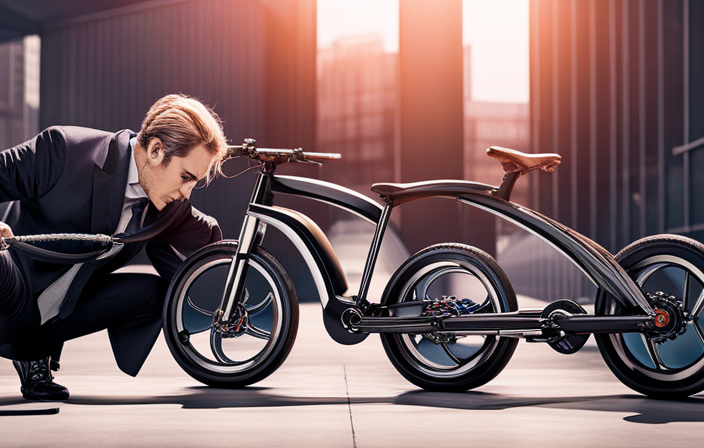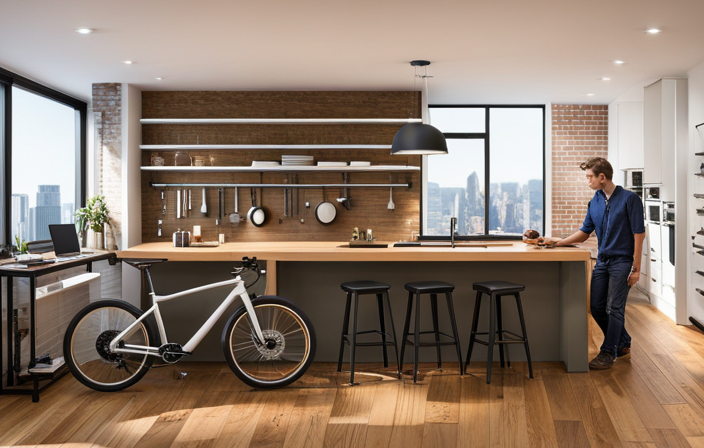I’ve got the ultimate solution for taking your one-gear bike to the next level. Imagine effortlessly cruising up hills and speeding along with the wind in your hair.
In this article, I’ll show you exactly how to transform your regular bike into an electric powerhouse. Get ready to assess compatibility, gather components, install the motor and battery, and ensure safety.
With these precise steps, you’ll be enjoying an electrifying ride in no time. Let’s get started!
Key Takeaways
- Assess the bike frame for any damage or cracks before beginning the conversion process.
- Choose a suitable electric motor and ensure compatibility with the bike’s components.
- Properly install the electric motor, ensuring it is securely mounted and aligned with the chainring.
- Install the battery and controller in a suitable location, considering accessibility, stability, and weight distribution.
Assess Your Bike’s Compatibility
First, you’ll need to assess if your bike’s frame and components are compatible with an electric conversion kit. Assessing your bike’s condition is crucial before proceeding with the conversion. Inspect the frame for any cracks or damage that could compromise its integrity. Check the wheels, tires, and brakes to ensure they are in good working order. Additionally, make sure the drivetrain, including the chain, cassette, and derailleur, is in good condition and functioning properly.
Once you’ve assessed your bike’s condition, the next step is to choose a suitable electric motor for your conversion. Consider factors such as the motor’s power output, torque, and compatibility with your bike’s frame and components. It’s important to select a motor that will provide enough power to assist you while riding, but not overpower the bike and compromise its handling.
After assessing your bike’s condition and choosing a suitable electric motor, you can proceed to gather the necessary components for the conversion. This includes the motor controller, battery, throttle, and wiring harness. These components will work together to power your bike and control the electric assist.
Gather the Necessary Components
Once you’ve got all the required components, it’s time to start assembling your new electric bike. Here’s what you need to do to get started:
-
Assessing compatibility: Before you begin, make sure that all the components you have are compatible with your bike. Check the specifications of your bike and compare them with the specifications of the electric bike conversion kit. Ensure that the motor, battery, and controller are all compatible with your bike’s frame and fork.
-
Securing the battery: The battery is a critical component of your electric bike, and it needs to be securely mounted on your bike. Find a suitable location on your bike’s frame or rack to install the battery. Ensure that it is securely fastened and won’t move or rattle while riding.
-
Mounting the motor: The motor is another crucial component of your electric bike. Follow the instructions provided with your conversion kit to install the motor onto your bike’s frame or rear wheel hub. Make sure it is properly aligned and securely attached.
With these steps completed, you are now ready to move on to the next section and prepare your bike for the electric conversion. It’s important to ensure that all the components are properly installed and secured before moving forward.
Prepare Your Bike
To get started, you’ll need to make sure your bicycle is in proper condition for the conversion. First, assess your bike’s condition to ensure that it is safe and suitable for an electric conversion. Check the frame for any cracks or damage, and make sure the brakes, chain, and gears are all functioning properly. It’s important to have a sturdy and reliable base for your electric bike.
Once you’ve assessed your bike’s condition, gather the necessary tools for the conversion. You’ll need a set of wrenches and screwdrivers, as well as a bike stand or something to prop your bike up on. Additionally, you may need a chain tool, a torque wrench, and some electrical tape. It’s important to have all the tools on hand before you begin the conversion process.
Now that your bike is in good condition and you have all the necessary tools, you’re ready to move on to installing the electric motor. This step will turn your regular bike into an electric one, giving you the power and convenience of an electric motor while still being able to pedal when you want to.
Install the Electric Motor
Now that your bicycle is in good condition and you have all the necessary tools, you’re ready to proceed with installing the electric motor.
When it comes to motor types and specifications, it’s important to choose the right one for your bike. Here’s a step-by-step guide to help you with the installation process:
- Begin by locating the ideal position for the motor on your bike frame. Consider factors such as weight distribution and accessibility to the battery and controller. Once you’ve determined the placement, secure the motor mount to the frame using the appropriate bolts or clamps. Ensure that it is tightly fastened to prevent any movement during operation.
Next, you’ll need to connect the motor to the drivetrain of your bike:
- Align the motor sprocket with the chainring of your bike’s pedal crank. This will allow for a seamless transfer of power from the motor to the wheels. Attach the motor sprocket to the chainring using a compatible chainring adapter or a dedicated motor chainring. Make sure the connection is secure to avoid any slippage.
With the electric motor successfully installed, you’re now ready to move on to the next step of the process: installing the battery and controller. By doing so, you’ll complete the transformation of your bike into an electric-powered machine.
Install the Battery and Controller
To successfully install the battery and controller, there are three key points to consider.
First, it’s crucial to find a suitable location for the battery that allows for easy accessibility and adequate ventilation to prevent overheating.
Second, it’s important to attach the battery securely to ensure it remains stable and in place during rides.
Find a suitable location for the battery
A good place to locate the battery is either in the frame or in the seat post. When considering battery placement, there are a few key factors to keep in mind.
Firstly, the battery should be positioned in a way that does not interfere with the functionality of the bike. It should be easily accessible for charging and maintenance. Additionally, optimal battery positioning ensures a balanced weight distribution, which is crucial for stability and maneuverability.
Placing the battery in the frame or seat post allows for a streamlined and compact design, reducing the chances of damage or theft. Once the ideal location is determined, it is important to attach the battery securely to prevent any movement or vibrations during rides. This ensures a safe and reliable power source for your electric bike.
Attach the battery securely
When attaching the battery securely, it’s important to ensure that there is no movement or vibrations during rides.
There are several battery attachment methods to consider based on the size and weight of the battery. For smaller batteries, using Velcro straps or zip ties can be effective in holding the battery in place. However, for larger and heavier batteries, a more robust mounting system may be required. This could include using custom brackets or frame mounts specifically designed for battery attachment.
It’s crucial to choose a method that provides a secure and stable connection, as any movement or vibrations can lead to damage or disconnection of the battery during rides.
Now, let’s move on to the next step: connecting the battery to the controller.
Connect the battery to the controller
After securely attaching the battery, you can connect it to the controller using the provided cables. This step is crucial for the proper functioning of your electric bike. Here’s how to connect the battery to the controller:
-
First, locate the controller on your bike. It is usually mounted near the handlebars or under the seat.
-
Next, identify the battery connection port on the controller. It should be labeled and easily visible.
-
Take the cable from the battery and insert it into the corresponding port on the controller. Ensure a secure and snug fit.
-
Once connected, double-check the connections to make sure they are tight and secure.
With the battery successfully connected to the controller, you are now ready to move on to the next step: installing the throttle or pedal-assist system. This will allow you to control the power and speed of your electric bike effortlessly.
Install the Throttle or Pedal-Assist System
To make your one-gear bike electric, start by installing the throttle or pedal-assist system. The throttle system allows you to control the speed of your electric bike with a simple twist of the handle, while the pedal-assist system provides electric assistance as you pedal. Both options offer a convenient and efficient way to convert your bike into an electric one.
When choosing between an electric throttle or pedal-assist conversion, consider your personal preferences and riding style. The table below highlights the main differences between the two systems:
| Electric Throttle | Pedal-Assist Conversion |
|---|---|
| Provides instant acceleration | Offers a more natural riding experience |
| Requires minimal effort to control speed | Requires pedaling to activate the motor |
| Ideal for those who want full control over acceleration | Suitable for riders who prefer a seamless integration of electric assistance |
Once you have decided on the system that best suits your needs, follow the manufacturer’s instructions to install it properly on your bike. This will involve attaching the throttle or pedal-assist sensor to the handlebars, connecting it to the controller, and securing the wiring.
Connect and Secure the Wiring
Now that the throttle or pedal-assist system is installed, it’s time to connect and secure the wiring for the electric conversion of my one-gear bike.
This step involves making the necessary connections between the different components of the system and ensuring that they are properly secured for long-term durability.
First, I carefully examine the wiring harness and locate the corresponding connectors for each component. Using the provided instructions, I connect the wires from the throttle or pedal-assist system to the appropriate connectors on the motor, battery, and controller. I double-check each connection to ensure they are snug and secure.
Once the wiring connections are completed, I proceed to secure the wiring for long-term durability. I use zip ties or cable clamps to neatly organize and secure the wires along the bike’s frame or handlebars. This not only prevents them from getting tangled or damaged during use but also minimizes the risk of accidental disconnection.
In the event of any wiring issues or malfunctions, troubleshooting becomes crucial. I carefully inspect each connection, checking for loose or damaged wires. If necessary, I use a multimeter to test the continuity of the wires and identify any potential faults.
With the wiring properly connected and secured, I am now ready to move on to the next section: test and adjust.
Test and Adjust
Once I’ve finished connecting and securing the wiring, it’s time to test and adjust the electric conversion on my bike.
The first thing I do is take it for a test ride to see how it performs. I pay close attention to the speed, acceleration, and overall handling. This allows me to identify any issues or areas that need improvement.
During the test ride, I also fine tune the settings to ensure optimal performance. I adjust the pedal assist level, throttle sensitivity, and motor power output. These adjustments can greatly affect the riding experience, so it’s crucial to get them just right.
Once I’m satisfied with the initial test ride and have made any necessary adjustments, I take the bike for another spin to confirm the changes. This iterative process helps me fine tune the settings until I achieve the desired performance.
Testing and adjusting the electric conversion is an essential step to ensure safety and compliance. By thoroughly testing the bike, I can identify any potential problems or issues that may compromise its functionality. Fine tuning the settings allows me to optimize the bike’s performance and ensure a smooth and enjoyable ride.
Ensure Safety and Compliance
Before riding an electric bike, it’s crucial to check local laws and regulations regarding their use. This will ensure that you are aware of any specific requirements or restrictions in your area.
Additionally, it’s important to install safety features such as lights and reflectors to enhance visibility and alert others to your presence on the road.
Lastly, regular inspection and maintenance of your electric bike is essential to ensure its optimal functioning and longevity.
Check local laws and regulations
Make sure you check local laws and regulations before converting your one-gear bike into an electric one. Researching local regulations is crucial to ensure that you comply with any safety requirements and avoid legal implications. Additionally, you should consider the insurance coverage for your electric bike. Some jurisdictions may require specific insurance for electric bicycles, so it’s important to understand your obligations. To provide a clearer understanding, I have included a table below summarizing the key aspects to consider when checking local laws and regulations.
| Local Laws and Regulations |
|---|
| Research local regulations |
| Ensure safety requirements |
| Consider legal implications |
| Check insurance coverage |
Install safety features like lights and reflectors
After ensuring that my one-gear bike complies with local laws and regulations, it’s crucial to prioritize safety by installing essential features.
Wearing a helmet while riding is of utmost importance to protect the head from potential injuries.
Additionally, installing a rearview mirror on the bike provides numerous benefits. It allows me to have a clear view of the traffic behind me, enhancing situational awareness and minimizing the risk of accidents.
By being able to see approaching vehicles or cyclists, I can make informed decisions and react in a timely manner. These safety measures significantly contribute to a safer riding experience.
Now, let’s transition to the subsequent section about regularly inspecting and maintaining your electric bike, which is essential for its longevity and optimal performance.
Regularly inspect and maintain your electric bike
Regularly inspecting and maintaining your e-bike is crucial in order to ensure its longevity and optimal performance. As a rider, it is important to follow a maintenance schedule and troubleshoot any issues that may arise. Here are some key steps to keep your electric bike in top condition:
- Check the tire pressure regularly to ensure proper traction and minimize wear.
- Inspect the brake pads for wear and replace them if necessary to maintain safe braking performance.
- Clean and lubricate the chain regularly to reduce friction and extend its lifespan.
- Regularly inspect the battery and charging system to ensure efficient power delivery.
By following these maintenance practices and referring to a troubleshooting guide when needed, you can enjoy a smooth and reliable electric ride.
Now, let’s dive into the next section and discover how to ‘enjoy your electric ride!’ without delay.
Enjoy Your Electric Ride!
Once you’ve converted your one-gear bike into an electric ride, you’ll be able to effortlessly enjoy the road ahead. The customization options for your electric bike are vast, allowing you to tailor your ride to your preferences and needs.
One crucial aspect of customization is choosing the right battery. When selecting a battery for your electric bike, you must consider factors such as capacity, voltage, and weight.
Capacity refers to the energy stored in the battery, which determines how far you can ride before needing to recharge. Higher capacity batteries offer longer rides, but they may also be heavier.
Voltage is crucial for the performance of your electric motor. Higher voltages provide more power and better acceleration. However, it’s essential to ensure that your motor can handle the selected voltage.
Another important consideration is the weight of the battery. Opting for a lighter battery can improve your bike’s maneuverability and overall performance. However, keep in mind that lighter batteries usually have lower capacities.
Ultimately, the right battery for your electric bike depends on your specific needs and preferences. It’s crucial to choose a battery that aligns with your desired range, power, and weight. By selecting the perfect battery, you’ll be able to fully enjoy the benefits of your electric ride.
Frequently Asked Questions
How much does it cost to convert a one-gear bike into an electric bike?
Converting a one-gear bike into an electric bike can be a cost-effective alternative to purchasing a new electric bike. The cost of electric bike conversion varies depending on the components and features chosen, such as the motor, battery, and controller. On average, it can range from $500 to $1500.
The advantages of converting a one-gear bike to electric include increased speed and range, easier uphill climbs, and reduced physical effort during longer rides.
Can I use any type of battery for the electric conversion?
Sure, you can’t just slap any old battery onto your electric conversion project. Battery compatibility is key. It’s like trying to fit a square peg in a round hole, except with volts and amps.
Different types of batteries have different charging requirements and power outputs. Lithium-ion batteries are a popular choice due to their high energy density, lightweight design, and long lifespan. They provide a reliable and efficient power source for your electrified ride.
How long does it take to install the electric motor?
Installing an electric motor on a bike typically takes around 1-2 hours, depending on your experience and familiarity with the process.
The tools required for this installation include a wrench, screwdriver, and possibly an Allen key set.
It is important to ensure that the motor is securely attached to the bike frame and that all electrical connections are properly made.
Following the manufacturer’s instructions is crucial to ensure a successful and safe installation.
Is it possible to switch back to a regular bike after converting it to electric?
Switching back to a regular bike after converting it to electric is indeed possible. However, it is important to consider the advantages and disadvantages.
One interesting statistic to note is that electric bikes provide an average speed of 15 mph, allowing for a faster commute.
The advantage of switching back is the simplicity and lighter weight of a regular bike, making it easier to maneuver. However, you would lose the convenience and assistance of the electric motor.
Are there any legal requirements or restrictions for riding an electric bike?
Safety regulations and licensing and registration requirements vary depending on the jurisdiction. It is important to be aware of them when riding an electric bike.
In many places, electric bikes are subject to the same safety regulations as regular bicycles. This includes using lights at night and wearing a helmet.
Additionally, some areas may require licensing and registration for electric bikes. This is especially true if they exceed certain speed or power limits.
It is crucial to research and comply with local laws to ensure a safe and legal riding experience.
Conclusion
So there you have it, folks! You now know how to transform your regular one-gear bike into an electrifying ride.
By following the steps outlined above, you can easily upgrade your bike’s performance and enjoy the convenience of an electric motor.
Remember to stay safe and comply with all regulations while riding your newly transformed electric bike.
Now get ready for an electrifying adventure that will make you feel like you’re flying through the streets with the power of a thousand lightning bolts!









